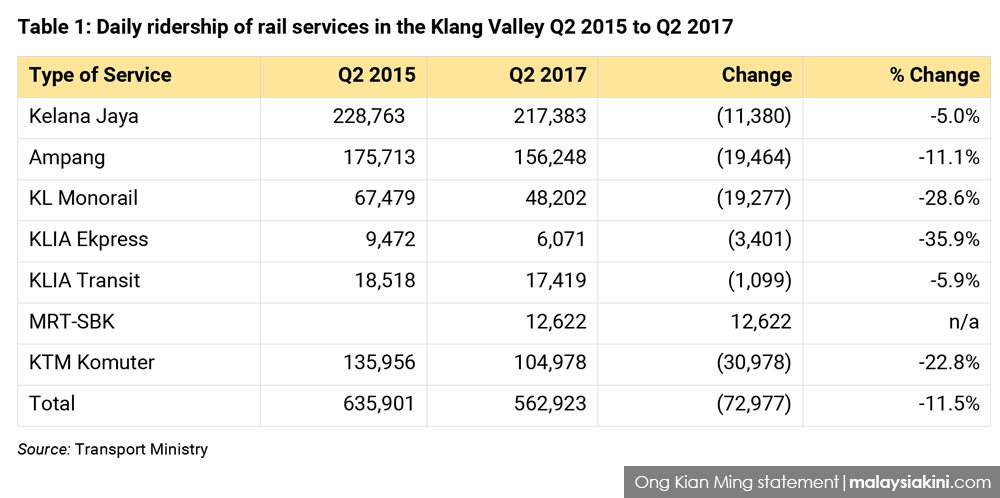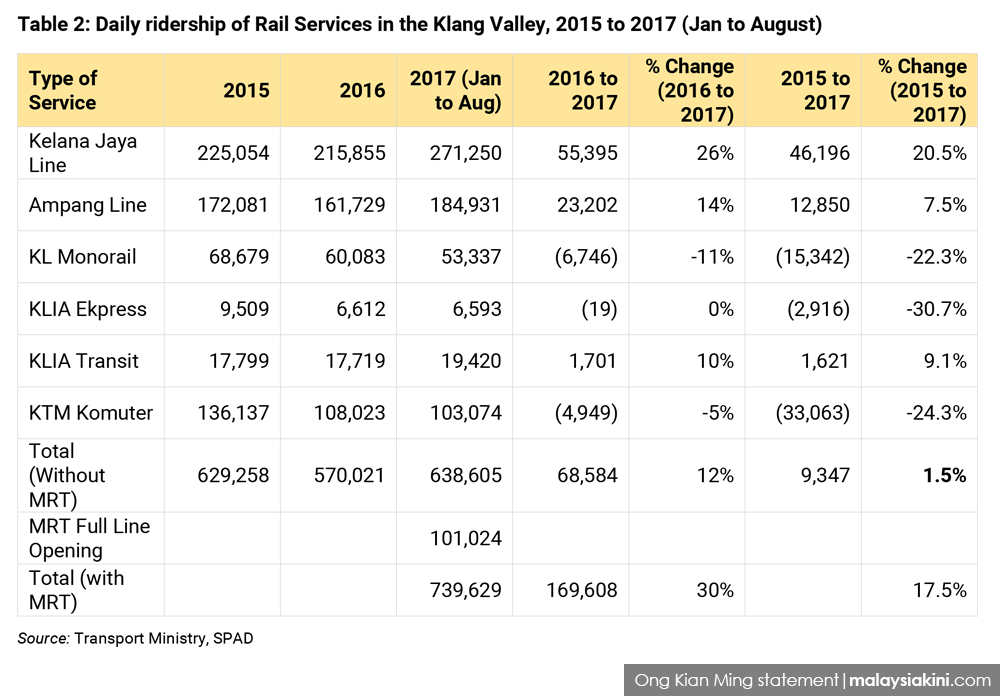MP SPEAKS | I would like to thank the Land Public Transport Commission (Spad) for its statement issued on Oct 9, which provides figures for rail ridership in 2016 and 2017.
As far as I can tell, Spad does not publish rail or bus ridership figures on its website, despite being the authority regulating most forms of public transportation. So this disclosure is a welcome beginning.
However, I stand by my earlier statement that rail ridership has decreased prior to the opening of the full Sungai Buloh-Kajang MRT Line 1 (MRT-SBK).
Table 1 below shows the changes in ridership from Q2 2015 to Q2 2017 (which is prior to the opening of the full MRT-SBK line). These statistics were obtained from the Transport Ministry website, which publishes quarterly rail statistics.

We can see that even with the inclusion of the partially opened MRT-SBK line, daily ridership fell from 635,901 in Q2 2015, to 562,923 in Q2 2017, a fall of 72,977 or 11.5 percent. In fact, ridership on all rail lines – not just the KTM Komuter – declined during this period.
I choose Q2 2015 as the starting point to evaluate the effects of the opening of the Sunway BRT in June 2015, and that of the LRT extension in June 2016 on the LRT ridership.
Despite the launch of the RM634 million Sunway BRT (which connects to the LRT system) and the RM8 billion LRT extension (which added 24 new LRT stations to the Kelana Jaya and Ampang lines), ridership on the KJ and Ampang lines actually fell by five and 11.1 percent respectively.
While I take note of the fact that Prasarana, which operates the monorail line, is involved in a contract dispute with Scomi, which has led to the removal of five four-car units on the monorail system, this is nevertheless part of the responsibilities of the operator (Prasarana) as well as the regulator (Spad).
Members of the public who use the rail system do not care about any contract disputes. If the service is not convenient or comfortable, they will not use it, and this is reflected in the decline in ridership of the monorail.
The figures released by Spad compares the daily ridership in 2016 with the daily ridership from January to August 2017. The daily ridership without the MRT line has increased by 12 percent from 2016 to 2017 (January to August), and by 30 percent if we include the MRT full line operations.
For some reason, Spad did not include the 2015 daily ridership figures. I include those figures in Table 2 below for comparison.

When we compare the 2015 daily ridership to the 2017 daily ridership, without the MRT full line, the increase is a mere 1.5 percent from 629,258 in 2015, to 638,605 in 2017 (January to August).
Furthermore, we have to take into account that the rail ridership figures released by Spad includes those for July-August 2017, when the LRT, Monorail and MRT fares were slashed by 50 percent (from July 17 to Aug 31st, 2017).
August was also when the SEA Games were being held, which would have increased traffic on the LRT lines (especially to the Bukit Jalil station).

But even with the novelty factor, the discounted rate and the SEA Games, the daily ridership of the MRT full line was only 101,024, which is below the target of 150,000, and far below the capacity of 400,000.
Even Spad acknowledges that the fare increase at the end of 2015 resulted in a nine percent drop in ridership in 2016. Would the ridership of the LRT and MRT also experience a similar decline once the discount period is over? Only time will tell.
I hope that the reason why I am highlighting these statistics is not misunderstood. It is not to criticise Spad or Prasarana for its own sake; I am strongly in support of public transportation, and want more people to use these services.
But if the projected increase in rail ridership is not happening, then we need to know the underlying causes. Is last mile connectivity via feeder buses the issue? Or the inconvenience in terms of additional time spent on the LRT and/or MRT? Or the high cost of parking at the park-and-ride facilities?
These are the issues which Spad and public transport operators must look into.
Finally, I call upon Spad to publish the daily ridership figures for the bus and rail ridership in the Klang Valley on a monthly basis, so that there is greater transparency on the number of people using the various rail services in Selangor and Kuala Lumpur.
In this day and age when the government is pushing for more big data initiatives, surely it would not be too much to ask for Spad to publish something as basic as daily ridership statistics?
ONG KIAN MING is Serdang MP and head of the Penang Institute in Kuala Lumpur.
The views expressed here are those of the author/contributor and do not necessarily represent the views of Malaysiakini.

